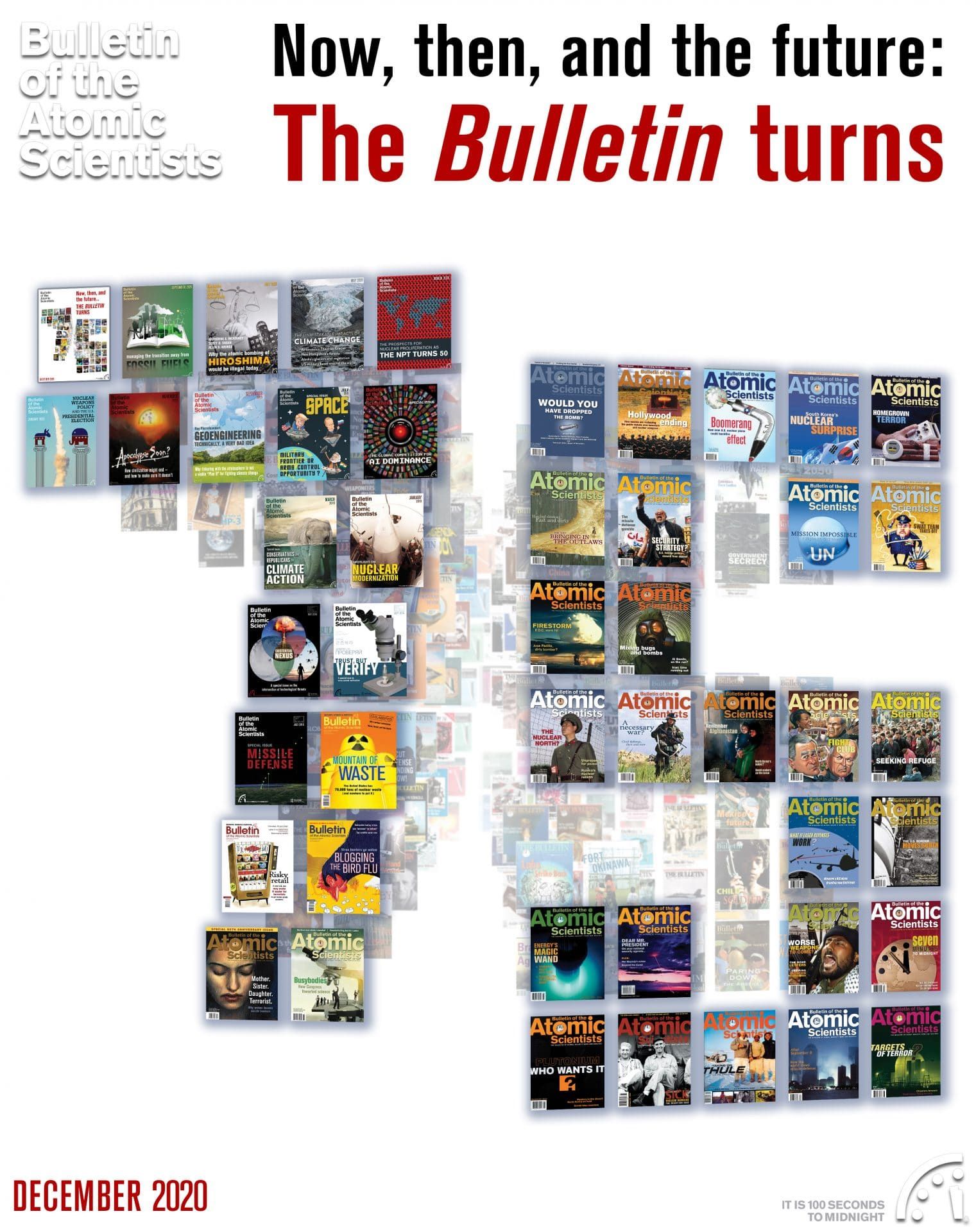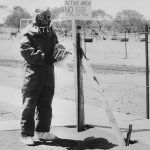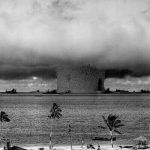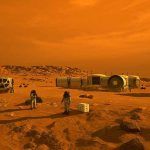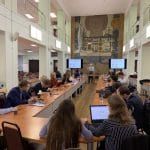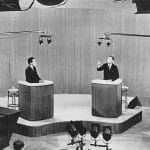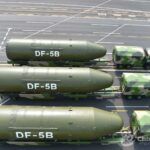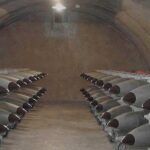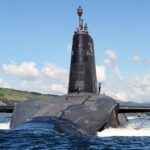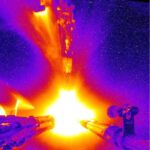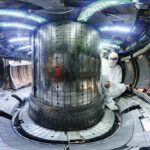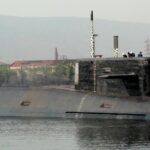2003: North Korea: No bygones at Yongbyon
By Robert Alvarez | December 7, 2020
2003: North Korea: No bygones at Yongbyon
By Robert Alvarez | December 7, 2020
Editor’s note: This article was originally published in the July/August 2003 issue of the Bulletin. It is republished here as part of our special issue commemorating the 75th year of the magazine.
November 16, 1994: The cold morning sky was clear as we took off from the Pyongyang airport in a dark green military helicopter bearing the distinct red-star emblem of the Democratic People’s Republic of Korea. As the vintage 1960s chopper flew with surprising quiet over the rough mountain terrain, Dr. Li Sang Gun, director of the “Radiochemistry Laboratory” at Yongbyon, and I made an attempt at small talk.
Dr. Li was escorting the first official U.S. delegation ever to visit his country to the highly secret Yongbyon nuclear complex 75 miles to the northwest. Here North Korea’s first small nuclear reactor lay dormant, with some 48 tons of highly radioactive spent fuel stored in a pool of water. That fuel contained enough plutonium for possibly five or six nuclear weapons.
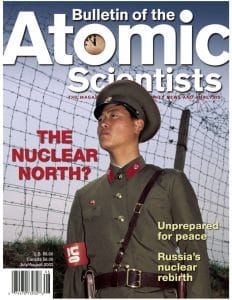 Li, in his 60s, was a thin, bespectacled man with graying hair and a formal, ramrod bearing. During the previous three days of often tense negotiations, he had headed the North Korean expert team. He clearly understood that as the highest ranking U.S. official then to visit North Korea, I was there to bring a halt to his life’s work.
Li, in his 60s, was a thin, bespectacled man with graying hair and a formal, ramrod bearing. During the previous three days of often tense negotiations, he had headed the North Korean expert team. He clearly understood that as the highest ranking U.S. official then to visit North Korea, I was there to bring a halt to his life’s work.
Several months earlier, our nations had been preparing for war over the very effort Li was directing—the reprocessing of spent fuel to extract plutonium for nuclear weapons. But on October 12, 1994, the United States and North Korea had signed the “Agreed Framework,” which moved both sides away from the brink.
North Korea agreed to freeze its plutonium production program in exchange for fuel oil, economic cooperation, and the construction of two modern light-water nuclear power plants. Eventually, North Korea’s existing nuclear facilities were to be dismantled, and the spent reactor fuel taken out of the country.

Securing the spent reactor fuel against plutonium production was the first order of business. And so we were immediately tasked to assemble a team to ensure that some 8,000 highly radioactive spent reactor rods could be safely stored and placed under surveillance by the International Atomic Energy Agency (IAEA).
On the way to Yongbyon, Li’s shyness and modesty became apparent, revealing a much different person than the stern figure across the negotiating table. Our conversation led to memories of the Korean War. It is impossible not to be reminded about the war in the “hermit nation”—the government has placed reminders everywhere in daily life.
For instance, during our first trip in November 1994, we visited an ancient temple near Yongbyon, where some 80,000 pages of Buddhist writings had been preserved since 500 A.D. Our lovely young guide gracefully pointed out damaged stone artifacts in the lush mountain pine grove, while standing next to a sign indicating that the area had been bombed by “American imperialist swine” during the war.
In 1950, communist forces led by North Korea’s military dictator Kim Il Sung invaded the South. By the time an armistice agreement was signed by North Korea, China, and the United Nations in 1953, the war, dubbed a “police action” by the United States, had produced more than four million civilian casualties and destroyed nearly every structure that had stood in the North. For half a century, the United States and South Korea have refused to sign the armistice—before my trip, a State Department official reminded me “not to be too friendly” while I was in North Korea, because, technically, “we are still in a state of war.”
I mentioned to Li that my generation knew little of the war. His memories, though, were sharp and deep. He grew up during the harsh colonial rule of the Japanese, which ended in 1945, creating great upheaval. The Korean War broke out when he was a young man. Betraying no emotion, he described U.S. napalm attacks and how there was no way to escape their horrors. He concluded, politely, that it would take a long time for North Koreans to overcome their hatred of Americans. After that, we retreated into silence.
Being there
The ancient resort city of Yongbyon is about 10 miles north of the nuclear site. For centuries, travelers have stopped there on their way to view the fabled Mount Yak San, which is 40 Bulletin of the Atomic Scientists July/August 2003 renowned for its lush springtime sea of flowering azaleas.
The nuclear complex, which covers some 50 square miles, was ringed with anti-aircraft batteries. Heavily guarded, it housed several hundred scientists, engineers, and nuclear workers in apartments, office buildings, nuclear laboratories, and other industrial facilities. Started in 1962, the facility underwent significant expansion in the 1980s with the construction of a 5-megawatt nuclear reactor, a nuclear fuel production plant, and a reprocessing plant where plutonium could be extracted from spent fuel rods for use in nuclear weapons.
The chopper landed near the 5- megawatt reactor, amid industrial and office buildings. The site was eerily reminiscent of U.S. nuclear weapons sites. As we stepped off, the head of North Korea’s nuclear program, General Li, a military and scientific leader, was there to greet us. Unlike the modest Dr. Li, the gregarious general wore tailored civilian dress clothing and a jaunty wool scarf. He cheerfully escorted us into a building, where we were briefed before making our first inspection.
We were ushered up a couple flights of stairs and into an icy cold lecture room, lit only by sunlight. We kept our coats, hats, and gloves on while a model nuclear fuel rod, about 2 feet long and 3 inches in diameter, was passed around the room for examination. No doubt, something similar was used in the 5- megawatt reactor, which until the Agreed Framework was signed, had made up for coal and fuel oil shortages by providing heat and electricity to North Korea’s nuclear elite in this closed village. The grim faces of our hosts, who walked around the room to keep warm, indicated that they now had to live and work in bitter cold like the ordinary people living nearby. The briefing was mercifully short, and we went to have a look at the reactor and the spent fuel.
There was fresh gravel on the ground in front of the reactor building. Since this is common practice at U.S. nuclear weapons sites to cover and shield radioactive contamination, I casually backed away toward an area where any hot spots would not have been covered over. But the noisy chirping from my small radiation detector alerted a guard who gestured, with his hand on his pistol, for me to return to the group. As I was not conducting a safety inspection, I quickly complied.
At the doorway of the reactor building stood an elderly man wearing a white hospital cap. In his hands he held an early Geiger counter, which he used to check our shoes. Glancing at our own radiation instruments, we knew his machine was broken—fortunately, no excess radiation levels were detected.
A small replica of a 1950s British nuclear power plant sat in the reactor room. The Yongbyon reactor, which started up in 1986, used graphite as a moderator and was cooled with pressurized carbon dioxide gas. Its fuel consisted of uranium metal encased in an alloy of magnesium and zirconium. There was no protective dome or secondary containment over the reactor to protect against a catastrophic radiation release, as is usually the case in the United States, South Korea, Japan, and Europe. The reactor vessel was built partially below ground, so that we could stand on its top.
Above the reactor was an overhead crane on a rail, used to place fresh fuel into the reactor’s several hundred channels. There the atoms of uranium metal would split, releasing energy and heat. If the reactor ran successfully for a year, about one half of one percent of the 48 tons of uranium fuel would be converted to plutonium 239. When the fuel was used up, the overhead crane would extract the now highly radioactive rods and drop them down a chute into an underground tunnel. Operators would use remote instruments to push them through the tunnel and place them in baskets submerged in a pool of water.
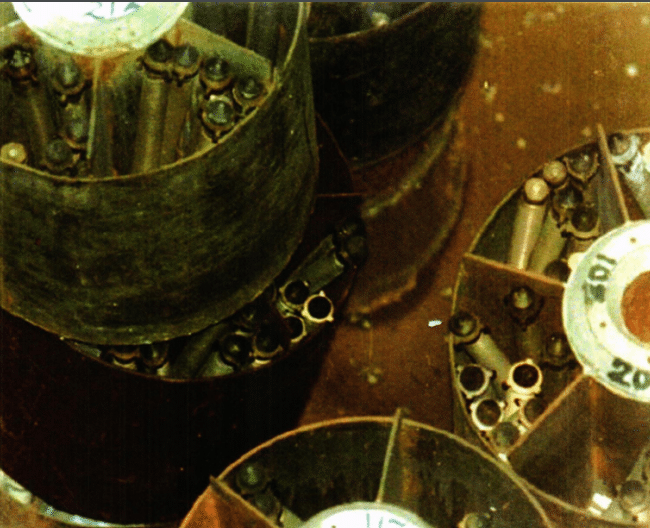
A few of these old-style reactors are still operating, mostly in Britain, but they have been effectively abandoned for less troublesome machines. General Li had trained in Russia after the “Atoms for Peace” program was announced by President Dwight D. Eisenhower in 1953, so I asked why this reactor design was chosen over Russian reactors (whose designs most resembled U.S. plutonium production reactors). He looked at me with a puzzled expression and replied that this simple design allowed his country to have an indigenous nuclear power program without relying on Russia or on anyone else.
North Korea’s nuclear program was true to the country’s philosophy of self-sufficiency, or “juche,” established by “Great Leader” Kim Il Sung.
A troubled history
North Korea has plenty of pure graphite and a high-grade uranium reserve of more than 26 million tons. The reactor did not require the use of enriched-uranium fuel, the production of which involves a much more complex technology (something that North Korea did not begin striving for until 1998 or perhaps a little earlier). Construction of two much larger reactors of the same design was frozen when the Agreed Framework was signed.
Building this type of reactor was also easier, General Li reasoned, because almost all of its important details had been available in the open literature of the “Atoms for Peace” program since the late 1950s, as were the designs for the Radiochemistry Laboratory, or reprocessing plant, for which Dr. Li was responsible.
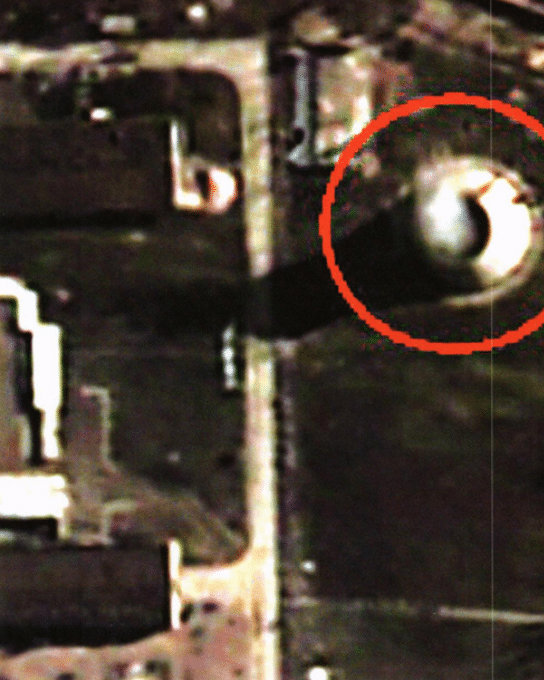
The Yongbyon reactor has some similarities to reactors at Russian and U.S. nuclear weapons sites—a graphite moderator and natural uranium metal fuel rods. But there are important differences. Using pressurized carbon dioxide instead of water for cooling reduces the risk of sudden, accidental power surges like that which led to the Chernobyl nuclear catastrophe in 1986. But the reactor’s most important feature is that it can more efficiently make plutonium than water-cooled graphite reactors.
The design is not without problems, however. The large size of the fuel core limits the ability to cool the reactor without reducing gas pressure below safe levels of operation. Also, the uranium metal fuel and its cladding can overheat, swell, and fail, causing prolonged shutdowns to remove damaged elements and clean up leaking radioactivity—a process that sometimes takes several months.
We discovered upon visiting the spent fuel storage areas that the reactor had had a troubled operating history. We first inspected a room near the reactor with a thick concrete lid covering most of the floor. Beneath it, in a dry pit, were some 700 damaged rods. Given so many failed fuel elements, we concluded that during its first five years of operation, the Yongbyon reactor had had to shut down for reasons other than refueling.
The remaining 7,700 fuel rods were in a window-lit cinder block building with peeling paint, where they sat in a concrete-lined pool of water roughly the size of a rectangular backyard swimming pool. The entire core had been hastily removed from the reactor in the spring of 1994 after a growing confrontation with the IAEA.
Two years earlier, the agency had found evidence that North Korea had reprocessed more than the 80 grams of plutonium 239 it had officially disclosed. When the IAEA then asked to inspect the reprocessing laboratory and radioactive waste tanks and analyze the spent fuel, North Korea refused, declaring instead that it would withdraw from the Nuclear Non-Proliferation Treaty. But now, tensions were reduced.
Because of the sunlight and seasonal temperatures, there was a layer of algae on the top of the water. We could barely see several rods not so neatly tumbled into the metal baskets, which were stacked two or three upon each other. The water was made murky by a suspension of magnesium oxide-rust from the fuel cladding. It looked something like a diluted form of “Milk of Magnesia” (also a form of magnesium oxide).
Attempts to clean the water and reduce the erosion of the cladding had clogged the filter equipment; it was broken and heavily contaminated. The North Koreans had then added large amounts of sodium hydroxide (lye), a caustic chemical, to try to retard the erosion. Unfortunately, sodium hydroxide can create pinhole leaks in the cladding—exposing the uranium metal to water. Once that happens, the uranium will interact with the moisture and give off flammable and explosive hydrogen. If the uranium fuel is pulled out of the water it may spontaneously ignite.

Our fears about the danger of the North Korean spent fuel were confirmed. The cladding could seriously erode in the not so distant future, allowing highly radioactive materials to escape into the pool, creating a severe radiological hazard. Fires caused by wet uranium added another risk. We left a few days later, sobered by what we had observed.
However, the new, Republican-controlled Congress did not share our urgency, and congressional leaders made no secret of their desire to kill the Agreed Framework. Despite the unprecedented access we were given to the Yongbyon nuclear complex, Congress only grudgingly funded the spent fuel project, which cost about $20 million.
Each individual spent fuel rod was brushed in clean water, rinsed, and placed in a stainless steel tube. To retard the generation of hydrogen, inert gas was injected before the tubes were sealed and tagged for IAEA inspectors. U.S. contractors with special equipment were brought in, and North Korea supplied labor. Because of radiation and fire concerns, the operation involved partitioning the existing pool to allow for an area of clean water where the underwater processing and canning of the rods by remote instruments could be observed. My last visit to North Korea was in January 1995, when we finalized arrangements. Subsequently, I was responsible for hiring contractors and developing the project budget for congressional approval in the fall of 1995.
By October 1997, the spent fuel rods were safely encased in steel containers, under IAEA inspection. The reactor remained closed, construction on two other, larger reactors had stopped, and the reprocessing plant sat idle. After the spent fuel project was established, I went on to other work, leaving my memories locked away like a disturbingly vivid dream.
Today’s crisis
Nearly eight years after our first visit, the situation was abruptly transformed. Last October, the United States confronted North Korea with the fact that it knew the North was secretly developing gas centrifuge technology to enrich uranium for nuclear weapons. The confrontation escalated over the next six months as the United States took the first step to terminate the Agreed Framework in November, suspending fuel oil shipments. North Korea responded the following month by announcing it would restart plutonium production and again announcing its withdrawal from the Nuclear Non-Proliferation Treaty.
The Clinton policy of engagement was rejected by the new administration (which also sucker-punched South Korean President Kim Dae Jung and his “sunshine policy” at the same time). The administration insisted that bilateral talks with North Korea were out of the question because the United States would not give in to “nuclear blackmail.” And until it agreed to meet with China and North Korea in late April, the administration was sticking to its guns, insisting that it was up to North Korea’s neighbors to exert pressure on North Korea to abandon its pursuit of nuclear weapons.
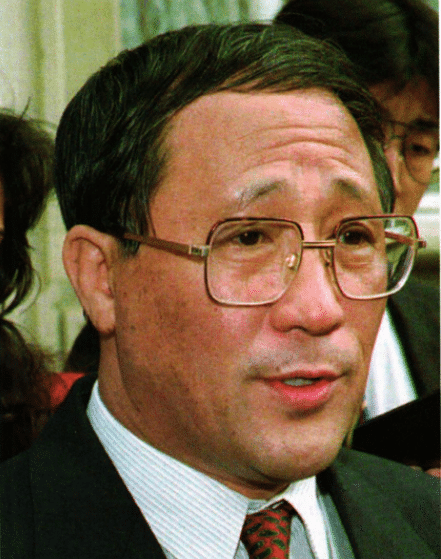
In February 2001, Secretary of State Colin Powell’s statement—that the United States would continue to pursue the Agreed Framework—was publicly rejected by the president. By January 2002, Bush named North Korea a charter member of the “axis of evil.” And only after 20 months of delay did the administration send its first official delegation to Pyongyang for formal talks in October of last year.
At that meeting, Assistant Secretary of State James Kelly announced that the United States knew about North Korea’s “secret” uranium enrichment program, and issued an ultimatum: North Korea had to cease its quest for uranium enrichment technology, or the United States would terminate the Agreed Framework.
Taken by surprise by Kelly’s ultimatum, Vice Foreign Minister Kang Sok-Ju ended the meeting. The next morning, Kang responded by claiming that North Korea possesses “more powerful” weapons and insisting that the United States agree to sign a non-aggression pact. Since then the situation has worsened.
It had already been publicly known at least since 1999 that the North Koreans were developing gas centrifuges with Pakistani help—the story had appeared in the Western press, but made the front page only in the Washington Times. Nonetheless, the Bush administration chose to drag its feet for more than 20 months, and then to hold the Agreed Framework hostage by forcing an “all or nothing” confrontation, which has blown up into a major and unexpected crisis.
Where do we go from here?
There is still some time for maneuvering. As for the gas centrifuge program, it takes thousands of high-precision centrifuges with reliable bearings and corrosion-resistant rotating parts of high endurance to make enough enriched uranium for several bombs. One U.S. intelligence official told Nuclear Fuel, a trade publication, in November 2002, that with significant manufacturing assistance “if we assume the DPRK started building machines in earnest a year ago, it might just be able to start” making enough enriched uranium for one weapon per year by 2005.
Based on this assessment, if the North resumes operations at Yongbyon, as it has announced, it could produce enough plutonium to make about 10 times as many plutonium-fueled nuclear weapons as enriched-uranium weapons. Even if the uranium enrichment program is more advanced than everyone assumes, the problem could probably have been worked out at the Pyongyang meeting in October. The Agreed Framework contained provisions that would impose full-scope international safeguards on such activities.
Several estimates indicate that North Korea may have somewhere between 7 and 22 kilograms of separated plutonium, roughly enough to fuel one or more, possibly up to five, nuclear weapons. The most recent estimate (by the CIA in November 1993) concluded that: “North Korea has a ‘better than even chance’ for ‘one or possibly two weapons.’” The North has said, somewhat ambiguously, that it has a nuclear weapon. But the CIA assessment is that there is “a ‘low probability’ that North Korea has assembled a nuclear weapon.”
That is because a plutonium-fueled nuclear weapon requires advanced machining and manufacturing capabilities. Moreover, the weapon has to be imploded by precisely machined high explosives. Given the uncertainties about making a plutonium weapon for the first time, there is no guarantee that it would work without testing.
Skeptics about the North Korean nuclear program include Gen. James Clapper, director of the Defense Intelligence Agency during the 1994 nuclear crisis, quoted by Leon V. Sigal in his 1998 book Disarming Strangers: “Personally, as opposed to institutionally, I was skeptical that they ever had a bomb. . . . We didn’t have smoking gun evidence either way. But you build a case for a range of possibilities. In a case like North Korea, you have to apply the most conservative approach, the worst-case scenario.”
North Korea’s efforts to make more plutonium will not yield results overnight. After more than eight years of dormancy, the startup of the 5-megawatt reactor will be time consuming work. Even before fuel is loaded into the reactor, key equipment, including the reactor controls, the overhead crane that places and removes fuel, the coolant piping, and the electrical systems will have to be checked and possibly repaired or replaced. It would have been difficult to address any repair problems after 1994; it would have violated the freeze, which was monitored on a 24-hour basis by the IAEA, which had permanent inspections at the site.
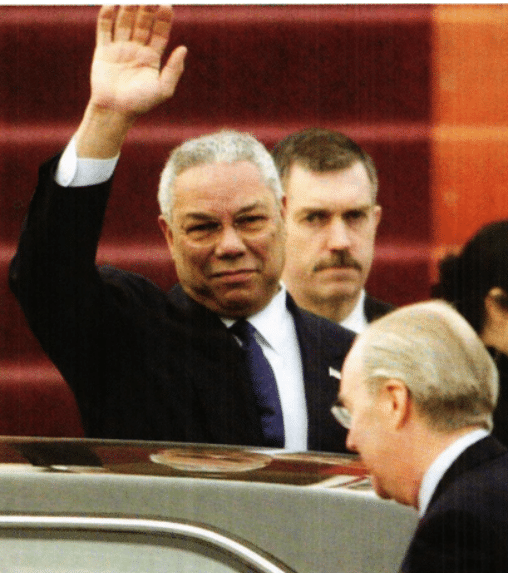
Pre-operational startup tests are required to make sure all systems are working and the reactor operators are following procedures. Once it is fueled, the reactor will have to be slowly brought up to full power. And since there was ample evidence that the reactor had a troubled operational history, it may be subject to unexpected shutdowns, for weeks if not months. Even assuming that everything worked perfectly, the reactor would have to operate almost continuously for about a year before it produced enough plutonium for five or six nuclear weapons.
As for using the existing spent fuel from the 5-megawatt reactor, enough time has elapsed for a significant amount of radiation to decay, which reduces the dangers to workers transporting the rods to the reprocessing plant. Frank von Hippel of Princeton University has made a “back of the envelope” calculation suggesting that each rod would give off about one rad per hour. “This dose would allow the rods to be placed on trucks in barrels of water, without incurring fatal doses to the workers,” he says.
But once the spent fuel reaches the reprocessing plant, other questions arise regarding North Korea’s capability to separate plutonium. The Radiochemistry Laboratory is comparable in size to those used in the United States to separate plutonium for nuclear weapons. Its main feature is a large building made of very thick concrete—it is almost as long as two football fields and six stories high, what is known as a “canyon” at U.S. nuclear weapons sites.
The fuel elements are chopped up inside the canyon and then dissolved in nitric acid. The dissolved fuel is then treated with a mixture of tributyl phosphate and kerosene in several complex steps to extract and purify plutonium and uranium.
Although the Radiochemistry Laboratory is intended to eventually process about 160 tons of spent fuel per year—nearly as much as the United States produced during the early heyday of the nuclear arms race, it has a long way to go before it reaches that level of production. It was in only the early stages of initial startup when its activities were frozen in 1994.
Just as with the 5-megawatt reactor, pre-operational equipment checks, repairs and maintenance, operator training, and small-scale trial runs are required before the plant is fully operational. Based on a 1950s design, the plant requires a significant amount of “hands-on” operations, relying less on the advanced remote controls used in other countries. Hands-on operations are more prone to spills, leaks, and chemical failures. These problems can lead to extended down times, and significant amounts of plutonium going into the waste stream, lowering the overall efficiency of the operation.
In the wake of claims made by North Korea in April at the Beijing talks that it is reprocessing spent reactor fuel, the Bush administration recently directed intelligence agencies to determine if there could be a clandestine operation. “We think they are bluffing,” one senior administration official told the New York Times in early May. “But we felt the necessity to go back and review every possibility, in the off chance that we missed something.” It’s possible that the North Koreans could haul the spent fuel to caves to chemically separate plutonium. Work in this kind of makeshift environment would be even more dangerous and definitely more time-consuming—it would involve handling much smaller batches of rods than the reprocessing plant and using “hot cells” to extract the tiny fraction of plutonium in the spent reactor fuel.
Under either of these circumstances, the time it will take North Korea to separate enough plutonium for several nuclear weapons and be on its way to making more is likely to run to several months, a year, or more. Regardless of the difficulties, the fierce dedication and willingness of North Koreans to make great sacrifices in order to have a nuclear arsenal should not be underestimated. Consider Pakistan, which continues to endure severe poverty and yet now possesses a growing nuclear weapons stockpile.
The one sure thing the Bush administration may have wanted to do, and the one sure error the administration made, was to try to terminate the Agreed Framework. For all the criticisms that have been leveled against it, the agreement successfully ended North Korean plutonium production for more than eight years. It also initiated the North’s slow rapprochement with South Korea and Japan—the first big step toward a nuclear-weapons-free Korean Peninsula.
Given the flaws in the Agreed Framework—the plan was to build two large light-water reactors even though the North would be unable to integrate them into its antiquated electrical grid—talks among the United States, China, and North Korea could produce a more workable solution.
Meanwhile, it has been very destructive to exaggerate North Korea’s nuclear capabilities, as a number of right-wing ideologues have encouraged the U.S. military and intelligence community to do, simply to advance their arguments in favor of the National Missile Defense program.
At the same time, the United States cannot afford to be complacent, even if North Korea has difficulty in restarting its plutonium program. Within the next several months to a year, the program could be restarted, and the window will have closed for making a bargain that prevents the North from seeking to build nuclear weapons.
Once that happens, the prospects of war on the Korean Peninsula may take center stage, even though the South Korean government has made it clear that it does not support a preemptive U.S. military action. A retaliatory response by North Korea, according to U.S. estimates, could result in more than a million South Korean casualties.
Together, we make the world safer.
The Bulletin elevates expert voices above the noise. But as an independent nonprofit organization, our operations depend on the support of readers like you. Help us continue to deliver quality journalism that holds leaders accountable. Your support of our work at any level is important. In return, we promise our coverage will be understandable, influential, vigilant, solution-oriented, and fair-minded. Together we can make a difference.
Keywords: 1994 Agreed Framework, North Korea, Yongbyon, archive75, plutonium separation
Topics: Nuclear Weapons

